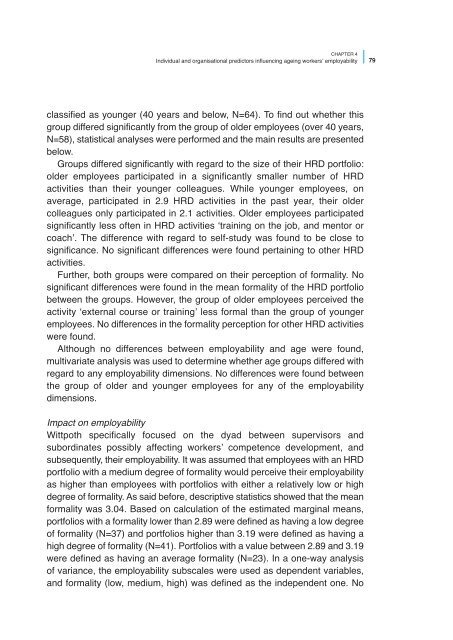Working and ageing - Cedefop - Europa
Working and ageing - Cedefop - Europa
Working and ageing - Cedefop - Europa
Create successful ePaper yourself
Turn your PDF publications into a flip-book with our unique Google optimized e-Paper software.
CHAPTER 4<br />
Individual <strong>and</strong> organisational predictors influencing <strong>ageing</strong> workersʼ employability 79<br />
classified as younger (40 years <strong>and</strong> below, N=64). To find out whether this<br />
group differed significantly from the group of older employees (over 40 years,<br />
N=58), statistical analyses were performed <strong>and</strong> the main results are presented<br />
below.<br />
Groups differed significantly with regard to the size of their HRD portfolio:<br />
older employees participated in a significantly smaller number of HRD<br />
activities than their younger colleagues. While younger employees, on<br />
average, participated in 2.9 HRD activities in the past year, their older<br />
colleagues only participated in 2.1 activities. Older employees participated<br />
significantly less often in HRD activities ʻtraining on the job, <strong>and</strong> mentor or<br />
coachʼ. The difference with regard to self-study was found to be close to<br />
significance. No significant differences were found pertaining to other HRD<br />
activities.<br />
Further, both groups were compared on their perception of formality. No<br />
significant differences were found in the mean formality of the HRD portfolio<br />
between the groups. However, the group of older employees perceived the<br />
activity ʻexternal course or trainingʼ less formal than the group of younger<br />
employees. No differences in the formality perception for other HRD activities<br />
were found.<br />
Although no differences between employability <strong>and</strong> age were found,<br />
multivariate analysis was used to determine whether age groups differed with<br />
regard to any employability dimensions. No differences were found between<br />
the group of older <strong>and</strong> younger employees for any of the employability<br />
dimensions.<br />
Impact on employability<br />
Wittpoth specifically focused on the dyad between supervisors <strong>and</strong><br />
subordinates possibly affecting workersʼ competence development, <strong>and</strong><br />
subsequently, their employability. It was assumed that employees with an HRD<br />
portfolio with a medium degree of formality would perceive their employability<br />
as higher than employees with portfolios with either a relatively low or high<br />
degree of formality. As said before, descriptive statistics showed that the mean<br />
formality was 3.04. Based on calculation of the estimated marginal means,<br />
portfolios with a formality lower than 2.89 were defined as having a low degree<br />
of formality (N=37) <strong>and</strong> portfolios higher than 3.19 were defined as having a<br />
high degree of formality (N=41). Portfolios with a value between 2.89 <strong>and</strong> 3.19<br />
were defined as having an average formality (N=23). In a one-way analysis<br />
of variance, the employability subscales were used as dependent variables,<br />
<strong>and</strong> formality (low, medium, high) was defined as the independent one. No

















